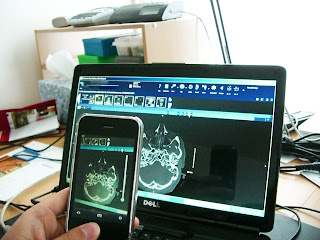To illustrate how such technology has eased communication in order for a patient to be seen quickly by a specialist was recently demonstrated when I received a phone call at home around 9:30PM from the Emergency Room regarding a facial fracture.
ER: Dr. Chang, we have a patient here who seems to have a facial fracture on CT. Overall, however, he does not appear to be in extreme discomfort and there does not appear to be any functional deficits.
Dr. Chang: Tell me about the fractures.
ER: It's a left zygomatic fracture. However, he is able to open and close the mouth as well as swallow without difficulty, so it's not emergent, but probably needs followup.
Dr. Chang: OK. What's his name? Tell him to come to my office in the morning at 9AM.
ER: Sounds great. Will let him know. His name is "John Doe" (not the patient's real name).
I than went to my home computer and loaded up his CT images to evaluate the so-called fracture. Often-times, most facial fractures do not require any intervention. However, some facial fractures, if severe enough, do require repair.
I loaded up the CT images and saw this (floating left zygomatic fracture):

Hmmmm. DOES need surgical intervention, but not something I can handle and this patient will need to see a specialist in facial fracture repair down at a tertiary care center like University of Virginia Medical Center. So, I take out my iPhone and take a picture of this relevant key image and email it to the facial plastic surgeon at UVA to arrange for an appointment (of note, no patient identifiers are included with the image to abide by HIPAA regulations).

Within a few hours, I get a reply back from the UVA plastic surgeon that this patient definitely needs surgical repair and that he would be able to see him the next day afternoon with surgery time blocked off for repair 3 days later.
The moral of the story is that technology is now good enough that given all information provided including radiological images (a picture is worth a thousand words), amazing things can happen, like get a patient seen in less than 24 hours by a sub-specialist who normally is unable to see new patients for 6-8 weeks. Without this image, it may have taken more effort and surgery may have been delayed by a week or two.
Patients can also do this if they are able to email their physician. It's not enough to provide only textual information which may not provide a compelling enough story... Include relevant images!!! Of course, you may need the help of a health professional to guide which images are most important.
It's worth repeating again...
Include relevant images!!!
The extreme importance of images is also why I ALWAYS want to see the CT scan images of any patients who comes in for an appointment and why patients should ALWAYS bring a copy of their CT scan burned onto a CD before seeing their ENT. A report is NOT good enough.
HOWEVER, the very importance of an image to a surgeon can be a double-edged sword as the image you send may PROVE that there's nothing significant going on to the point that a specialist may say that scheduling an appointment would not be worthwhile.
















0 comments:
Post a Comment